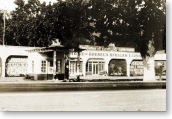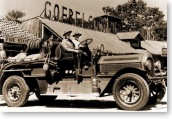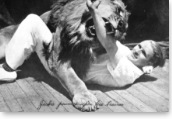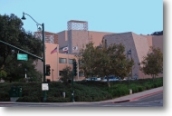 

 |
|
|
Goebel's Jungleland was originally called Goebel's Lion Farm when it opened in 1927, but it would later be known simply as Jungleland. Louis Goebel was born in Buffalo, New York, in 1896.
 He moved to California in 1919 where he worked at Gay's Lion Farm, a popular tourist attraction dedicated to the breeding, training, and exhibition of African lions. Goebel was employed in the butchering of animal carcasses as food for the lions. The following year, when Gay's Lion Farm moved from Hollywood to El Monte, Goebel began working at Universal Studios' animal zoo. An avid animal lover, Goebel lived on the grounds and in time was put in charge of caring for and training all the zoo animals housed at Universal. In 1926, Universal's Chief, Carl Laemmle, decided to sell their animal stock. Goebel recognized an extraordinary opportunity and eagerly bought six of the lions
He moved to California in 1919 where he worked at Gay's Lion Farm, a popular tourist attraction dedicated to the breeding, training, and exhibition of African lions. Goebel was employed in the butchering of animal carcasses as food for the lions. The following year, when Gay's Lion Farm moved from Hollywood to El Monte, Goebel began working at Universal Studios' animal zoo. An avid animal lover, Goebel lived on the grounds and in time was put in charge of caring for and training all the zoo animals housed at Universal. In 1926, Universal's Chief, Carl Laemmle, decided to sell their animal stock. Goebel recognized an extraordinary opportunity and eagerly bought six of the lions
 (Andy, Min, Bill, Momma, Poppa and Little Caesar), several dogs, rabbits, chickens, a fox, and other small animals. He began looking in nearby Thousand Oaks for a location to house his animals. After petitioning the county seat in Ventura for permission to house lions, Goebel bought five lots by the Ventura Highway (now Thousand Oaks Boulevard) in the Oak Springs development. He paid $10 per lot, immediately put up fences, and began building animal cages. In 1927, Goebel's Lion Farm opened to the public. It was located on the southwest corner of Thousand Oaks Boulevard and Conejo School Road. At one point, the noise from some of his cats disturbed a nearby neighbor, Kathleen Parks, who apparently went to the Farm and complained. Six months later, on June 20, 1928, she and Louis Goebel were married and made the Lion Farm their home.
(Andy, Min, Bill, Momma, Poppa and Little Caesar), several dogs, rabbits, chickens, a fox, and other small animals. He began looking in nearby Thousand Oaks for a location to house his animals. After petitioning the county seat in Ventura for permission to house lions, Goebel bought five lots by the Ventura Highway (now Thousand Oaks Boulevard) in the Oak Springs development. He paid $10 per lot, immediately put up fences, and began building animal cages. In 1927, Goebel's Lion Farm opened to the public. It was located on the southwest corner of Thousand Oaks Boulevard and Conejo School Road. At one point, the noise from some of his cats disturbed a nearby neighbor, Kathleen Parks, who apparently went to the Farm and complained. Six months later, on June 20, 1928, she and Louis Goebel were married and made the Lion Farm their home.
 Spectators flocked from all over to see the many animals Goebel had trained. Goebel's Lion Farm also became a popular place for circuses to spend the winter putting on free shows for tourists. In 1931, Goebel took his animals to the Lake Sherwood area where MGM's Tarzan, the Ape Man (1932), starring Johnny Weissmuller and Maureen O'Sullivan, was being filmed. He camped on the grounds with his animals to ensure that they would be hired for the film. Many of his animals would soon appear in other films as well, such as his water buffalo, Pappy, who appeared in The Good Earth (1937), the screen adaptation of Pearl Buck's novel, starring Paul Muni and Luise Rainer. Eventually, Goebel's Lion Farm changed its name to Goebel's Wild Animal Farm and grew in size to approximately 170 acres. Tourists from all over Southern California came to visit the wild animal attraction, greatly increasing the area's popularity.
Spectators flocked from all over to see the many animals Goebel had trained. Goebel's Lion Farm also became a popular place for circuses to spend the winter putting on free shows for tourists. In 1931, Goebel took his animals to the Lake Sherwood area where MGM's Tarzan, the Ape Man (1932), starring Johnny Weissmuller and Maureen O'Sullivan, was being filmed. He camped on the grounds with his animals to ensure that they would be hired for the film. Many of his animals would soon appear in other films as well, such as his water buffalo, Pappy, who appeared in The Good Earth (1937), the screen adaptation of Pearl Buck's novel, starring Paul Muni and Luise Rainer. Eventually, Goebel's Lion Farm changed its name to Goebel's Wild Animal Farm and grew in size to approximately 170 acres. Tourists from all over Southern California came to visit the wild animal attraction, greatly increasing the area's popularity.
Thousand Oaks became synonymous with "Home of Goebel's African Lions" (see Thousand Oaks). Sadly, on July 8, 1940, a fire broke out in the hay barn and swept through the compound, injuring six Bengal tigers and two of the elephants (Sally and Queenie), all of whom had to be euthanized.
 Sally apparently panicked after being slightly burned and stumbled into an arroyo from which she could not climb out. She had to be destroyed so that she would not burn to death. In a tragic irony, the other elephant, Queenie, was burned about the head, and in her panic ran blindly, tripped over and broke the main water line, which made it more difficult to extinguish the fire. Goebel's head trainer, the renowned Louis Roth, was devastated. Another fire took the life of a third elephant, Bonnie, while she was en route to the Centennial Fair at Salt Lake City in July 1947. These elephants had been rogues, acquired by Goebel after their owners had been closed down by authorities for non-payment of taxes. Besides appearing in MGM Tarzan films, these elephants had also appeared in Hal Roach's One Million B.C. (1940) disguised as woolly mammoths.
Sally apparently panicked after being slightly burned and stumbled into an arroyo from which she could not climb out. She had to be destroyed so that she would not burn to death. In a tragic irony, the other elephant, Queenie, was burned about the head, and in her panic ran blindly, tripped over and broke the main water line, which made it more difficult to extinguish the fire. Goebel's head trainer, the renowned Louis Roth, was devastated. Another fire took the life of a third elephant, Bonnie, while she was en route to the Centennial Fair at Salt Lake City in July 1947. These elephants had been rogues, acquired by Goebel after their owners had been closed down by authorities for non-payment of taxes. Besides appearing in MGM Tarzan films, these elephants had also appeared in Hal Roach's One Million B.C. (1940) disguised as woolly mammoths.
Louis Goebel's animal acts were leased to circuses and to various movie studios in need of the four-legged actors. In time, Goebel's Lion Farm became known throughout California and eventually all over the world. In 1945, Louis Goebel sold his wild animal compound to Trader Horne, a Kansas City animal importer/exporter, and Billy Richards.
 They renamed it World Jungle Compound. One of the animals Horne brought back from Africa for his new venture was a chimp he named Peggy. The chimp, trained by Henry Tyndall, would win 2nd place in the 1953 Patsy Awards for her role in the comedy sequel, Bonzo Goes to College (1952), starring Maureen O'Sullivan and Edmund Gwenn. She also played Tamba in the Jungle Jim series starring Johnny Weissmuller, and Kimbbo in the Bomba series starring Johnny Sheffield. Melvin Koontz, who had joined the World Jungle Compound in 1946, became their chief animal trainer until his retirement in 1964. Koontz received his training at the old Selig Zoo and had taken a trained animal act to the New York World's Fair in 1939. Koontz also trained Jackie the Lion who appeared in some of the RKO Tarzan films and was a regular trainer for Sam Katzman's Jungle Jim features.
They renamed it World Jungle Compound. One of the animals Horne brought back from Africa for his new venture was a chimp he named Peggy. The chimp, trained by Henry Tyndall, would win 2nd place in the 1953 Patsy Awards for her role in the comedy sequel, Bonzo Goes to College (1952), starring Maureen O'Sullivan and Edmund Gwenn. She also played Tamba in the Jungle Jim series starring Johnny Weissmuller, and Kimbbo in the Bomba series starring Johnny Sheffield. Melvin Koontz, who had joined the World Jungle Compound in 1946, became their chief animal trainer until his retirement in 1964. Koontz received his training at the old Selig Zoo and had taken a trained animal act to the New York World's Fair in 1939. Koontz also trained Jackie the Lion who appeared in some of the RKO Tarzan films and was a regular trainer for Sam Katzman's Jungle Jim features.
 World Jungle Compound continued to operate much in the same way as during the Goebel years until 1956 when it was sold to 20th Century Fox and turned into an amusement park. The park was renamed Jungleland. Some of the new buildings at Jungleland were designed by architect Roy C. Wilson. Over the years, a lot of filming was done at the park, and it was home to some of the most famous animals in both movies and television, including MGM’s trademark Leo the Lion and Mr. Ed, the talking horse. During the various transitions of his original Lion Farm, Goebel remained active in the wild animal export business. He supplied many animals to various zoos across the United States, including the first zoo in Hawaii. In the late 1940s, he was responsible for supplying most of the rhesus monkeys used in the development of the polio vaccine.
World Jungle Compound continued to operate much in the same way as during the Goebel years until 1956 when it was sold to 20th Century Fox and turned into an amusement park. The park was renamed Jungleland. Some of the new buildings at Jungleland were designed by architect Roy C. Wilson. Over the years, a lot of filming was done at the park, and it was home to some of the most famous animals in both movies and television, including MGM’s trademark Leo the Lion and Mr. Ed, the talking horse. During the various transitions of his original Lion Farm, Goebel remained active in the wild animal export business. He supplied many animals to various zoos across the United States, including the first zoo in Hawaii. In the late 1940s, he was responsible for supplying most of the rhesus monkeys used in the development of the polio vaccine.
In 1961, Goebel reacquired the property through foreclosure. Money problems plagued the family for years, however, in part due to the ever increasing popularity of other amusement parks such as Disneyland and Knott's Berry Farm. Unable to compete with these larger parks, Jungleland was forced to close its gates for a final time in 1969.
 Jungleland was auctioned off, including 1,800 of its animals. The Goebels retained some of the animals, as well as ownership of the land which they later sold to the City of Thousand Oaks. The Jungleland Compound was demolished in the mid-1970s.
Jungleland was auctioned off, including 1,800 of its animals. The Goebels retained some of the animals, as well as ownership of the land which they later sold to the City of Thousand Oaks. The Jungleland Compound was demolished in the mid-1970s.
From the time Goebel's Lion Farm opened its doors in 1927, this wild animal attraction had a tremendous impact on the Thousand Oaks area, transforming it from a remote rural area to a popular tourist destination. What began as an animal training center for Hollywood became a nationally known amusement park that attracted visitors from all over the world. In 1981, Louis Goebel died at his home at the age of 84. Kathleen Goebel died in 2004 at age 98. Today, the Thousand Oaks Civic Arts Plaza occupies a portion of the original Jungleland site.
|
| |
 |
|